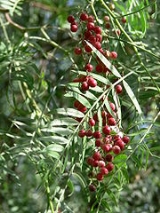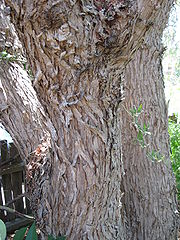
Schinus molle
Encyclopedia
Peruvian Pepper is an evergreen tree
that grows to 15 meters (50 feet). It is native to the Peru
vian Andes
. The bright pink fruits of Schinus molle are often sold as "pink peppercorns" although S. molle is unrelated to true pepper (Piper nigrum).
species and potentially the longest lived. The upper branches of the tree tend to droop. The tree's pinnately compound
leaves measure 8-25 cm long x 4-9 cm wide and are made up of 19-41 alternate leaflets. Male and female flowers occur on separate plants (dioecious
). Flowers are small, white and borne profusely in panicles at the ends of the drooping branches. The fruit
are 5-7 mm diameter round drupe
s with woody seeds that turn from green to red, pink or purplish, carried in dense clusters of hundreds of berries that can be present year-round. The rough grayish bark is twisted and drips sap. The bark, leaves and berries are aromatic when crushed.
S. molle is a drought tolerant, long-lived, hardy evergreen species that has become a serious invasive weed internationally. In South Africa, for example, S. molle has invaded savanna and grasslands and become naturalised along drainage lines and roadsides in semi-desert. It is also invasive throughout much of Australia in a range of habitats from grasslands to dry open forest and coastal areas, as well as railway sidings and abandoned farms. In the United States, either S. molle or its close relative Schinus terebinthifolius is particularly invasive in Florida and Hawaii, and can also be found in southern Arizona, southern California, Texas, Louisiana and Puerto Rico.

(S. terebinthifolius), are sold as pink peppercorns and often blended with commercial pepper. The fruit and leaves are, however, potentially poisonous to poultry, pigs and possibly calves. Records also exist of young children who have experienced vomiting and diarrhea after eating the fruit.
Extracts of S. molle have been used as a flavor in drinks and syrups.
word for the tree, 'molli.
The Inca used the sweet outer part of ripe fruit to make a drink. Berries were rubbed carefully to avoid mixing with the bitter inner parts, the mix strained and then left for a few days to produce a refreshing and wholesome drink. It was also boiled down for syrup or mixed with maize to make nourishing gruel.
There is also significant archaeological evidence that the fruits of S. molle were used extensively in the Central Andes
around 550-1000 AD for producing chicha
, a fermented alcoholic beverage.
Tree
A tree is a perennial woody plant. It is most often defined as a woody plant that has many secondary branches supported clear of the ground on a single main stem or trunk with clear apical dominance. A minimum height specification at maturity is cited by some authors, varying from 3 m to...
that grows to 15 meters (50 feet). It is native to the Peru
Peru
Peru , officially the Republic of Peru , is a country in western South America. It is bordered on the north by Ecuador and Colombia, on the east by Brazil, on the southeast by Bolivia, on the south by Chile, and on the west by the Pacific Ocean....
vian Andes
Andes
The Andes is the world's longest continental mountain range. It is a continual range of highlands along the western coast of South America. This range is about long, about to wide , and of an average height of about .Along its length, the Andes is split into several ranges, which are separated...
. The bright pink fruits of Schinus molle are often sold as "pink peppercorns" although S. molle is unrelated to true pepper (Piper nigrum).
Description
Schinus molle is a quick growing evergreen tree that grows to 15 meters (50 feet) tall and 5-10 meters (16-33 feet) wide. It is the largest of all SchinusSchinus
Schinus is a genus of flowering trees and tall shrubs in the sumac family, Anacardiaceae. Members of the genus are commonly known as pepper trees. The Peruvian Pepper Tree is the source of the spice known as pink peppercorns but can become serious invasive species outside their natural habitats...
species and potentially the longest lived. The upper branches of the tree tend to droop. The tree's pinnately compound
Pinnate
Pinnate is a term used to describe feather-like or multi-divided features arising from both sides of a common axis in plant or animal structures, and comes from the Latin word pinna meaning "feather", "wing", or "fin". A similar term is pectinate, which refers to a comb-like arrangement of parts...
leaves measure 8-25 cm long x 4-9 cm wide and are made up of 19-41 alternate leaflets. Male and female flowers occur on separate plants (dioecious
Dioecious
Dioecy is the property of a group of biological organisms that have males and females, but not members that have organs of both sexes at the same time. I.e., those whose individual members can usually produce only one type of gamete; each individual organism is thus distinctly female or male...
). Flowers are small, white and borne profusely in panicles at the ends of the drooping branches. The fruit
Fruit
In broad terms, a fruit is a structure of a plant that contains its seeds.The term has different meanings dependent on context. In non-technical usage, such as food preparation, fruit normally means the fleshy seed-associated structures of certain plants that are sweet and edible in the raw state,...
are 5-7 mm diameter round drupe
Drupe
In botany, a drupe is a fruit in which an outer fleshy part surrounds a shell of hardened endocarp with a seed inside. These fruits develop from a single carpel, and mostly from flowers with superior ovaries...
s with woody seeds that turn from green to red, pink or purplish, carried in dense clusters of hundreds of berries that can be present year-round. The rough grayish bark is twisted and drips sap. The bark, leaves and berries are aromatic when crushed.
Distribution
S. molle is native to the arid zone of Northern South America and Peru's Andean deserts, and goes to Central Chile and Central Argentina. It has, however, become widely naturalized around the world where it has been planted as an ornamental and for spice production.S. molle is a drought tolerant, long-lived, hardy evergreen species that has become a serious invasive weed internationally. In South Africa, for example, S. molle has invaded savanna and grasslands and become naturalised along drainage lines and roadsides in semi-desert. It is also invasive throughout much of Australia in a range of habitats from grasslands to dry open forest and coastal areas, as well as railway sidings and abandoned farms. In the United States, either S. molle or its close relative Schinus terebinthifolius is particularly invasive in Florida and Hawaii, and can also be found in southern Arizona, southern California, Texas, Louisiana and Puerto Rico.

Culinary
Although not related to commercial pepper (Piper nigrum) the pink/red berries, like the berries of its close relative the Brazilian pepperBrazilian pepper
Schinus terebinthifolius is a species of flowering plant in the cashew family, Anacardiaceae, that is native to subtropical and tropical South America...
(S. terebinthifolius), are sold as pink peppercorns and often blended with commercial pepper. The fruit and leaves are, however, potentially poisonous to poultry, pigs and possibly calves. Records also exist of young children who have experienced vomiting and diarrhea after eating the fruit.
Extracts of S. molle have been used as a flavor in drinks and syrups.
Medicinal
In traditional medicine, S. molle was used in treating a variety of wounds and infections due to its antibacterial and antiseptic properties. It has also been used as an antidepressant and diuretic, and for toothache, rheumatism and menstrual disorders, with recent studies providing some support for its antidepressant effects. It has also been speculated that S. molles insecticidal properties make it a good candidate for use as an alternative to synthetic chemicals in pest control.History
The word 'molle' in 'Schinus molle' comes from the QuechuaQuechua languages
Quechua is a Native South American language family and dialect cluster spoken primarily in the Andes of South America, derived from an original common ancestor language, Proto-Quechua. It is the most widely spoken language family of the indigenous peoples of the Americas, with a total of probably...
word for the tree, 'molli.
The Inca used the sweet outer part of ripe fruit to make a drink. Berries were rubbed carefully to avoid mixing with the bitter inner parts, the mix strained and then left for a few days to produce a refreshing and wholesome drink. It was also boiled down for syrup or mixed with maize to make nourishing gruel.
There is also significant archaeological evidence that the fruits of S. molle were used extensively in the Central Andes
Andes
The Andes is the world's longest continental mountain range. It is a continual range of highlands along the western coast of South America. This range is about long, about to wide , and of an average height of about .Along its length, the Andes is split into several ranges, which are separated...
around 550-1000 AD for producing chicha
Chicha
For the musical genre, see Peruvian cumbiaChicha is a term used in some regions of Latin America for several varieties of fermented and non-fermented beverages, rather often to those derived from maize and similar non-alcoholic beverages...
, a fermented alcoholic beverage.

